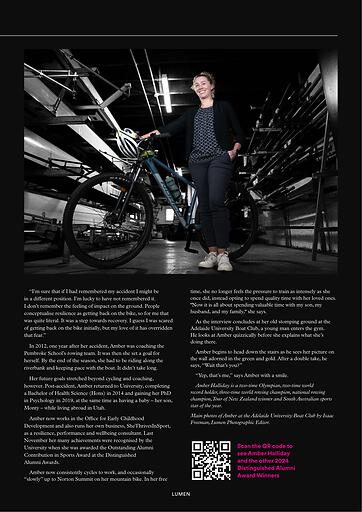Lumen Autumn 2025 - Flipbook - Page 18

Music
Another oscillation of the pendulum, and I am four years old,
standing outside Bonython Hall next door. Adults swirl around
me in flapping black gowns as I cling tightly to my father’s leg.
He takes me and my little brother upstairs to the balcony, so that
we can watch something incomprehensible happen to our mother
on the stage. Some months earlier, she had danced out of the
medical school back to our car on Frome Road – I’ve passed! I’ve
passed! – and the builders on the scaffold renovating the façade had
broken into a round of applause. The medical school was not very
hospitable to young mothers in those days, and it was an enormous
achievement that she had pulled this off. Now – a single click of
that metronome – I am wearing one of these flapping gowns
myself, reading out the names of our latest crop of graduates from
that same stage. As I gaze across this sea of shining faces, I can
almost see the bewildered expressions of two small children at the
front of the balcony. They are a long way away, but they are also
very close.
“MUSIC IS AN ART WRITTEN
ON TIME: THE BEAT, THE BAR,
THE PHRASE.”
Time is supposed to be linear, but more and more it seems to
move in loops. And sometimes it stands still, just for a moment.
During the pandemic, when we had to teach piano over Zoom, one
of my students in China lost her sense of time. Her scales became
erratic; her Beethoven stalled, before scrambling towards the end
of the phrase. Finally, I asked her to place a metronome in front of
the camera, and then watched, fascinated, as it traced its trajectory
through the air and froze mid-stroke. It was the world that had lost
sense of time, not my student. In music, a fermata is a pause of
unspecified duration, represented ironically by the symbol known
as corona. After a few moments, her metronome clicked back to life
and swooped towards the next beat.
Sometimes I think time is the most profound subject of art:
Proust’s À la recherche du temps perdu; Messiaen’s Quatuor
pour la fin du temps. Sometimes I think it is the only subject.
My grandfather passed away last year, but there is a plaque on a
seat in Elder Hall, acknowledging a donation he and my beloved
grandmother made during our most recent fundraising campaign.
He doesn’t really need a plaque; he is there anyway. For years I
used his metronome for my practice, until it became so wayward
I surrendered, and uploaded an App to my phone instead.
When I returned to the Elder Conservatorium after many
years of living away, the common room still smelt the same, and
the intercom in the green room made the same startling sound,
jolting performers onto the stage as if from a dream. Thirty years
after I entered this building as an undergraduate, I addressed
our new student cohort for the first time as director. I cannot
remember much about that day, but I vividly remember that other
day, 30 years earlier: the maroon t-shirt and khaki shorts I was
wearing; the Body Shop lotion I had rubbed into my legs; the vistas
of adulthood lying reassuringly ahead, where I liked them.
Professor Anna Goldsworthy is Director of the Elder Conservatorium
of Music, and an award-winning pianist, author and playwright.
The metronome in the image belonged to Anna’s grandfather, Reuben
Goldsworthy, also an accomplished teacher and pianist who gifted this
symbol of time to his granddaughter, along with his lifelong passion
for music.
Photos by Isaac Freeman, photographic editor of Lumen.
18













